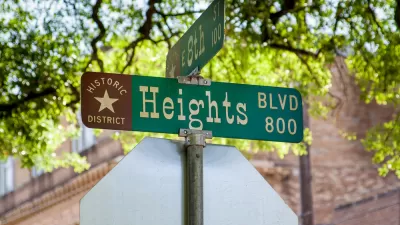New research seeks to provide a better understanding of the relationship between historic preservation and neighborhood change in the LGBTQ community.

In an article in Planning Magazine, Kelly Kinahan and Matthew H. Ruther discuss their research into "the relationship between locally designated and National Register historic districts, and demographic, socioeconomic, and housing changes in 46 U.S. cities," with a particular focus on "unmarried partnered same-sex households (UPSSHs), racial and ethnic subgroups, and median household income."
Their findings showed that in historic districts created in the 1990s, "when historic districts are in place, significant growth in UPSSHs follows," indicating that "planners concerned with protecting queer spaces should consider incorporating preservation-based approaches, including establishing local and National Register historic districts to preserve these spaces." The results also showed that "the presence of male UPSSHs increases the likelihood of locally designated historic districts," which "could suggest that male UPSSHs are key actors in the creation of locally designated historic districts, which aligns with the theory that gay men use historic preservation tools to demarcate space and power. Locally designated historic districts offer a more direct means of land control through the regulations outlined within the ordinances that govern changes to the district's built environment, which differ from NRHDs' mostly honorific status." Lastly, while historic designation seems to cause long-term displacement of racial and ethnic subgroups, the same does not hold true for UPSSHs.
The authors acknowledge the limitations of studying UPSSHs exclusively, reminding planners to "work with neighborhood residents to ensure all LGBTQ social histories and those of other historically marginalized groups are included in the significance statements for new historic district designations where appropriate."
"A more robust understanding of how preservation tools relate to neighborhood change — particularly among sexual, racial, and ethnic minority communities — can help planners as they grapple with the potentially negative effects of gentrification and displacement that could result from historic district designation." The authors hope that their research "will help practicing planners understand trends associated with historic preservation efforts and pinpoint interventions needed in historic districts to mitigate potentially negative outcomes for these demographic groups."
FULL STORY: Historic Preservation and the LGBTQ Community

Planetizen Federal Action Tracker
A weekly monitor of how Trump’s orders and actions are impacting planners and planning in America.

Maui's Vacation Rental Debate Turns Ugly
Verbal attacks, misinformation campaigns and fistfights plague a high-stakes debate to convert thousands of vacation rentals into long-term housing.

Restaurant Patios Were a Pandemic Win — Why Were They so Hard to Keep?
Social distancing requirements and changes in travel patterns prompted cities to pilot new uses for street and sidewalk space. Then it got complicated.

In California Battle of Housing vs. Environment, Housing Just Won
A new state law significantly limits the power of CEQA, an environmental review law that served as a powerful tool for blocking new development.

Boulder Eliminates Parking Minimums Citywide
Officials estimate the cost of building a single underground parking space at up to $100,000.

Orange County, Florida Adopts Largest US “Sprawl Repair” Code
The ‘Orange Code’ seeks to rectify decades of sprawl-inducing, car-oriented development.
Urban Design for Planners 1: Software Tools
This six-course series explores essential urban design concepts using open source software and equips planners with the tools they need to participate fully in the urban design process.
Planning for Universal Design
Learn the tools for implementing Universal Design in planning regulations.
Heyer Gruel & Associates PA
JM Goldson LLC
Custer County Colorado
City of Camden Redevelopment Agency
City of Astoria
Transportation Research & Education Center (TREC) at Portland State University
Jefferson Parish Government
Camden Redevelopment Agency
City of Claremont





























